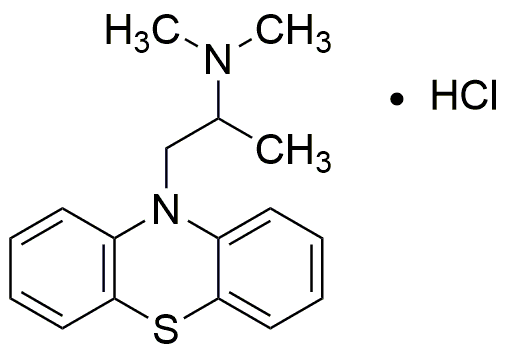Promethazine hydrochloride is widely utilized in research focused on:
- Allergy Relief: Commonly used in the treatment of allergic reactions, it helps alleviate symptoms such as itching, runny nose, and hives, making it essential in allergy clinics and hospitals.
- Motion Sickness Prevention: This compound is effective in preventing nausea and vomiting associated with motion sickness, making it valuable for travel-related industries, such as cruise lines and airlines.
- Preoperative Sedation: In medical settings, it is often administered to patients prior to surgery to provide sedation and reduce anxiety, enhancing patient comfort and cooperation.
- Sleep Aid: Due to its sedative properties, it is used in some formulations to help individuals with insomnia, providing a non-habit forming option for sleep disturbances.
- Antiemetic Use: It is effective in controlling nausea and vomiting caused by chemotherapy, making it a critical component in oncology treatment protocols.
General Information
Properties
Safety and Regulations
Applications
Promethazine hydrochloride is widely utilized in research focused on:
- Allergy Relief: Commonly used in the treatment of allergic reactions, it helps alleviate symptoms such as itching, runny nose, and hives, making it essential in allergy clinics and hospitals.
- Motion Sickness Prevention: This compound is effective in preventing nausea and vomiting associated with motion sickness, making it valuable for travel-related industries, such as cruise lines and airlines.
- Preoperative Sedation: In medical settings, it is often administered to patients prior to surgery to provide sedation and reduce anxiety, enhancing patient comfort and cooperation.
- Sleep Aid: Due to its sedative properties, it is used in some formulations to help individuals with insomnia, providing a non-habit forming option for sleep disturbances.
- Antiemetic Use: It is effective in controlling nausea and vomiting caused by chemotherapy, making it a critical component in oncology treatment protocols.
Documents
Safety Data Sheets (SDS)
The SDS provides comprehensive safety information on handling, storage, and disposal of the product.
Product Specification (PS)
The PS provides a comprehensive breakdown of the product’s properties, including chemical composition, physical state, purity, and storage requirements. It also details acceptable quality ranges and the product's intended applications.
Certificates of Analysis (COA)
Search for Certificates of Analysis (COA) by entering the products Lot Number. Lot and Batch Numbers can be found on a product’s label following the words ‘Lot’ or ‘Batch’.
Numéro de catalogue
Numéro de lot/série
Certificates Of Origin (COO)
This COO confirms the country where the product was manufactured, and also details the materials and components used in it and whether it is derived from natural, synthetic, or other specific sources. This certificate may be required for customs, trade, and regulatory compliance.
Numéro de catalogue
Numéro de lot/série
Safety Data Sheets (SDS)
The SDS provides comprehensive safety information on handling, storage, and disposal of the product.
DownloadProduct Specification (PS)
The PS provides a comprehensive breakdown of the product’s properties, including chemical composition, physical state, purity, and storage requirements. It also details acceptable quality ranges and the product's intended applications.
DownloadCertificates of Analysis (COA)
Search for Certificates of Analysis (COA) by entering the products Lot Number. Lot and Batch Numbers can be found on a product’s label following the words ‘Lot’ or ‘Batch’.
Numéro de catalogue
Numéro de lot/série
Certificates Of Origin (COO)
This COO confirms the country where the product was manufactured, and also details the materials and components used in it and whether it is derived from natural, synthetic, or other specific sources. This certificate may be required for customs, trade, and regulatory compliance.


